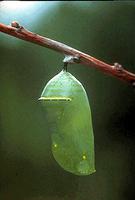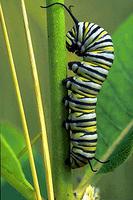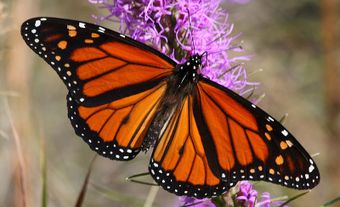Butterfly, term referring to insects of order Lepidoptera [Gk "scaly wings"]. The Canadian fauna includes 272 known species, compared to 695 known from North America as a whole, and over 20 000 worldwide. Possibly about 60 species remain to be discovered or recorded in Canada.
Structure
Butterflies are characterized by having antennae that are knobbed or hooked at the tips. They fly by day and are usually brightly coloured. Species found in Canada are varied in size, wingspans ranging from under 2.5 cm to 7.5 cm. Adults have a long, hollow tongue (proboscis) and usually feed on nectar. Larvae of all butterflies in Canada feed on vegetation.
Reproduction and Development
The life cycle of a given species may require from a few weeks to 2 years to complete, and involves a complete metamorphosis through egg, larva (caterpillar) and pupa (chrysalis) to adult. Different families have characteristically shaped and marked eggs, which are usually laid on a host plant, singly or in batches of up to 300. Species differ in ways of overwintering: most pass the winter in the egg, larval or pupal stage, but a few (eg, mourning cloak and Milbert's tortoiseshell) overwinter as adults.
Range
Butterflies inhabit all areas of Canada where flowering plants occur. Their numbers diminish northwards, down to about 16 species in the Arctic. Although some species (eg, red admiral and common sulphur) are widely distributed, others are confined to particular habitats or geographical regions. Monarch and painted lady butterflies migrate to Canada from the US.
Butterfly populations are controlled by inclement weather, diseases, parasites, predators and habitat suitability. Cool, sunless summers and mild, damp winters are particularly detrimental. Birds consume many caterpillars and adults, while dragonflies and spiders also take their toll. Diseases can be particularly rife when population densities are high, but the many parasitic flies and wasps that regularly prey on caterpillars probably exert the greatest natural control.
Larvae of some species of blues and hairstreaks are tended by ants for the honeydew they secrete, and probably receive some protection from other insects. Natural controls are necessary and probably do not threaten the existence of butterflies. However, destruction of natural habitats, large-scale spraying to control insect pests and, possibly, acid rain are man-made hazards that could have far-reaching detrimental effects on Canada's butterfly fauna.
Interaction with Humans
Although butterflies are generally harmless to human interests, a few are pests. Larvae of cabbage white butterflies are a widely distributed pest of plants of the cabbage family, while another accidentally introduced butterfly, the European skipper, has become a pest of hayfields. Occasionally, others may become a local nuisance when unusually high population levels develop.
Butterflies are useful in plant pollination, in providing food for other creatures, and as indicators of environmental stability. They are a source of scientific and recreational interest, bringing charm and beauty to wherever they live. See also monarch butterfly.
How did an ice age determine what animals and insects are only now found on the land we now call Canada? Leah and Falen go way, way back to find the answers. See also: "Ours To Save," a special report from the Nature Conservancy of Canada and NatureServe Canada. Link: https://bit.ly/33dpT6H
Note: The Secret Life of Canada is hosted and written by Falen Johnson and Leah Simone Bowen and is a CBC original podcast independent of The Canadian Encyclopedia.

 Share on Facebook
Share on Facebook Share on X
Share on X Share by Email
Share by Email Share on Google Classroom
Share on Google Classroom










